Battenboard
A variation of laminboard with the core formed of strips.
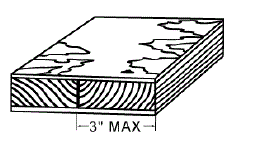
Baluster
One of a set of posts supporting a stair handrail.
Balustrade
The protective barrier alongside a staircase or landing.
Banister
See Balustrade.
Batten
A narrow strip of wood.
Beaded wood
A simple round moulding. Also see Moulded wood.
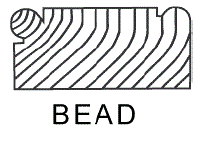
Bevel
An angle but not a right angle. A sloping or canted surface.
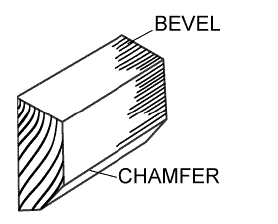
Bole
The tree trunk is sometimes also called the bole. After felling, the branches are removed, leaving the trunk – at this stage it’s known as a log.
Broad-leaved trees
Broad-leaved trees produce hardwood timber. Their seeds are in an enclosed case or ovary, such as an acorn or walnut. In temperate climates they’re usually deciduous – they lose their leaves in winter.
Blockboard
A variation of laminboard with a core formed of square wood strips glued together.
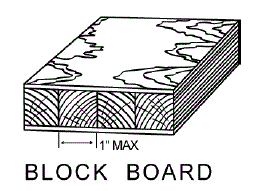
Casing
The timber lining of a door opening.
Cellular wood panel
Similar to blockboard and battenboard panels but the battens and laths form the core and are spaced either parallel or in lattice form. Panels are relatively light but have some strength.
Chamfered
The edges have been removed lengthwise at an angle.

Composites
“Structural timber composites” is the collective name for engineered wood-based materials or components. Those currently available include:
• glued laminated timber or glulam
• laminated veneer lumber (LVL)
• parallel strand lumber (PSL)
• laminated strand lumber (LSL)
Conversion
The process of cutting logs by sawing them into usable sections of timber, such as beams and planks.
Counterbore
To cut a hole that allows the head of a bolt or screw to sit flush with or lie below the level of a surface.
Countersink
To cut a tapered recess that allows the head of a screw to lie flush with a surface.
Cup
To bend as a result of shrinkage, specifically across the width of a piece of wood.
Dado
The lower part of an interior wall, usually defined with a moulded rail.
Densification
A chemical or physical treatment – layers are bonded together with treatment in excess of that needed to ensure a good bond – to increase hardness and improve mechanical strength or resistance to chemical or electrical agencies.
Density
The mass per unit volume of a substance, usually expressed in kilograms per cubic metre.
Distortion
The change in the shape of a piece of timber or timber-based material brought about by shrinkage as the timber dries. It includes bowing, twisting and cupping.
Dovetail
A type of joint. One piece has a splayed shape – like a dove’s tail – and fits into the socket or eye of the second piece.

Doweling
Cylindrical piece or length of wood. Also known as rounded wood.

Drip groove
A groove cut or moulded in the underside of a door or window sill to prevent rainwater running back to the wall.
Dry board
See Wet processing.
Earlywood
The less dense wood formed during the early stage of a growth season.
Eaves
The edges of a roof that project beyond the walls.
Edge and end spacing
Spacings between fasteners and the edges and ends of the components that are being joined.
End grain
The exposed face of timber produced when it’s cut through a plane that’s perpendicular to the grain.
End-jointed
See Finger-jointed.
Engineered wood
Layers of hardwood compressed together.
Extruded particle board
Particle board made using extrusion. This may have holes running internally from end to end.

Face edge
In woodworking, the surface planed square to the face side.
Face side
In woodworking, the flat planed surface from which other dimensions and angles are measured.
Fascia board
A strip of wood that covers the ends of rafters and to which external guttering is fixed.
Fibreboard
Wood chips bonded together by their own adhesive properties – lignin. Known as hardboard, mediumboard and softboard.
Finger-jointed
Also called end-jointed. Shorter pieces of wood are joined to create a longer piece of wood. The joint looks like interlaced fingers.

Floor board
Material for forming the surface of floors.
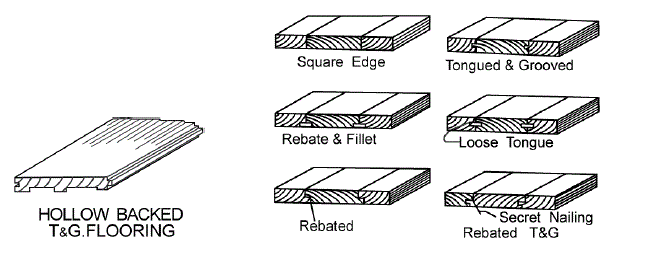
Foliage
Leaves.
Furring battens
Parallel strips of wood fixed to a wall or ceiling to provide a framework for attaching panels.
Glulam
Glulam or glued laminated timber is one of a range of structural timber composites. Glulam is made by gluing together strength graded laminates to produce large section structural components that can be straight or curved. Beams are manufactured in stock or bespoke sizes.
Going
The horizontal measurement between the top and bottom risers of a stair or the depth of one stair tread.
Grain
The general direction of wood fibres or the pattern produced on the surface of timber by cutting through the fibres. Also see End grain and Short grain.
Groove
A long narrow channel. Also see Tongued and grooved.
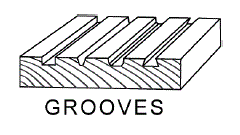
Hardboard
See Fibreboard.
Hardwood
Timber produced from broad-leaved trees.
Head
The top horizontal member of a wooden frame.
Head plate
The top horizontal member of a stud partition.
Heartwood
The inner area of a tree trunk or log that – when the tree was growing – had stopped containing living cells and reserve materials, such as starch. The heartwood may be darker in colour than the outer sapwood though not all species show a clear difference between the two. The heartwood is often more durable than sapwood.
Horns
Extended door or window stiles designed to protect the corners from damage while in storage.
Impregnation or injection
The injection and impregnation of wood are treatments to preserve the wood and give it durability, to make it fire resistant and protect against shrinkage. The treatment ensures the long-term preservation of poles of coniferous wood. The treatment involves soaking the timber for a long period in open vats of hot liquid in which the poles are left until the liquid cools down. Alternatively, they can be treated in an autoclave through a vacuum or under pressure or the wood can be deeply impregnated – usually with thermosetting plastics or molten metal. Impregnation with thermosetting plastics – for example amino-resins or phenolic resins – is often applied to very thin veneers that are built up into laminated wood but not to solid wood.
Interlocking joint
Interlocking is a way of jointing timber. Each piece is cut to fit against or into another to prevent displacement and to transfer forces. The joint must either be in compression or pinned or keyed after assembly.
Jamb
The vertical side member of a door or window frame.
Kerf
The groove cut by a saw.
Knot
The remains of a branch in timber. A branch sawn off close to the trunk or shed naturally forms a sound or live knot. A broken branch stub that becomes surrounded by new growth produces a loose or dead knot in the timber.
Laminated veneer lumber (LVL)
LVL is a layered composite of wood veneers and adhesive and can be considered as a veneer based product. It’s made up of parallel laminations of veneer, glued and processed together to form a material that’s similar to sawn timber. Debarked spruce logs are soaked in hot water. Blocks are cut into a thick veneer and then cut into sheets and lengths. Veneers are dried to a moisture content below 5 per cent. The veneers are ultrasonically graded, with the higher grade placed on the outer faces of the plank. A scarf saw makes long chamfers in both ends of the veneers. Thermosetting phenolic resin glue is spread on the upper side of each sheet – except on the upper faces – and laid up so the grain direction is all the same. The veneers are pressed to spread the glue evenly before entering a hot-press. LVL is very similar to parallel strand lumber.
Laminated wood
Several thin layers of wood and adhesives that are built up to make a single board.
Laminboard
Thick compound board with a core that’s usually made up of small strips, glued together at right angles and with a surface of other woods.

Ligneous
Of wood or resembling wood, woody. Examples of ligneous materials other than wood are bagasse, bamboo, cereal straw, and flax or hemp shives.
Lignin
The natural adhesive and bonding properties found in the cellular structure of wood and used for bonding together fibreboard and similar products.
Marquetry
A pattern of inlaid veneers that usually consists of thin pieces of wood or other material – such as base metal, shell or ivory – glued to a wooden backboard for decoration.
Microporous
Used to describe a type of finish that allows timber to dry out while protecting it from rainwater.
Mitre
Two pieces forming an angle, or a joint formed between two pieces of wood by cutting bevels of equal angles at the ends of each piece.

Mediumboard
See Fibreboard.
Mortise
A recess or hole, formed in one piece to receive a projection or tenon on the end of another piece.

Moulded wood
Strips of wood – known as mouldings or beadings – shaped with contours for decoration or ornament.

Movement
The swelling and shrinkage of wood as a result of changing moisture content. Movement in length is always negligible. Movement parallel with the growth rings is greater than at right angles to them. The degree of movement varies between species.
Mullion
A vertical dividing member of a window frame.
Muntin
A central vertical member of a panel door.
Newel
The post at the top or bottom of a staircase that supports the handrail.
Nogging
A short horizontal wooden member between studs.
Nosing
The front edge of a stair tread.
Oriented strand board (OSB)
To make OSB, logs are fed into a lathe-like machine where the bark is removed and the machine chews up the logs completely to produce flakes of wood. These flakes are sifted to eliminate the very tiny particles, then mixed thoroughly with a dust of waxes and heat-triggered resin glues. Layers of the fibres are placed in alternating directions – alternately at right angles – until the desired thickness is achieved. This is placed in a thermal press that activates and compresses the loose materials at the same time, causing the wax covered resin to activate and bond. The panels are trimmed and grade stamped.
Parallel strand lumber
This is a structural wood product made from softwood veneer that has been sized into long and narrow strips that are then glued into parallel laminations. It’s very similar to laminated veneer lumber.
Particle board
Woodchips, sawdust, wood residues and so on that are bound or glued together to form a flat board.
Peeling
See Rotary cut.
Permeability
The ease with which liquids – such as preservatives or flame retardants – can be impregnated into timber. Permeability varies with species, although the sapwood of all species is more permeable than the heartwood. Permeability ratings relate to the heartwood of the species.
Planed
Smooth surfaced.
Planking
Planking is available in various widths and is available with tongue and groove in lengths or as plain square edged planks that simply butt up against one another.
Plywood
To create plywood, the bark is removed from a log and the bare log is placed on a lathe-type machine that peels off thin layers of wood, usually after the wood has been steamed or soaked in hot water. The sheets of wood are sorted according to the number of knot holes, grain imperfections and so on. The best sheets become the outside – face sheet or veneer sheet – of the plywood. These layers are laid down edge to edge with their grain running perpendicular to the panel’s grain, then spliced, taped, stitched or glued together. The rough-edged panel then goes to the trimming area where it’s cut to the appropriate size and grade stamped.
Pointside
The piece of timber in a joint that receives the point of a nail or screw. The other section is known as the headside.
Preservative treatment
The treatment of timber with chemicals to improve its resistance to attack by biological organisms, such as fungi, insects and marine borers. The chemicals can be brushed or sprayed onto the surface of the timber but treatment is more effective if the chemicals are impregnated into the timber under vacuum and/or pressure in special treatment vessels.
Purlin
A horizontal beam that provides intermediate support for rafters or sheet roofing.
Rafter
One of a set of parallel sloping beams that form the main structural element of a roof.
Ray
A narrow ribbon of cells that conducts and stores food in a tree. Rays run across the grain of timber.
Rebated
The edge has been cut to form a step, usually as part of a joint.

Reveal
The vertical side of an opening in a wall.
Riser
The vertical part of a step.
Rotary cut
The log is mounted in a large lathe and turned against the blade which peels the veneers in long sheets. Also called peeling or slicing.
Rounded wood
See Dowelling.
Sanded
Smooth surfaced – smoother than a planed surface.
Sandwich construction
A warm roof construction where the insulation is located above the roof deck but below the weatherproof membrane. May also refer to composite panel products – known as sandwich panels – where panels are built up from layers of different materials.
Sap
Liquid – mostly water – contained within cells in a tree or timber. Sap is the means by which dissolved food and salts are moved around the tree.
Sapwood
The outer area of a tree trunk or log, which in the growing tree contains living cells and reserve materials such as starch. Sapwood is generally lighter in colour than the inner heartwood, although not all species show a clear difference between the two. The sapwood is more vulnerable to attack by biological organisms but is also usually more permeable than the heartwood – this makes it easier to treat with preservatives.
Sash
A type of window or the opening part of a window.
Shake
Wood that’s split to reveal its natural texture.
Shingle
Wood sawn lengthwise that’s thicker at one end – the butt – and thinner at the other end – the tip.
Short grain
When the general direction of wood fibres lies across a narrow section of timber.
Sill
The lowest horizontal member of a stud partition or the lowest horizontal member of a door or window frame.
Skirting or skirting board
A moulded base board or plinth to an inside wall. Also called a washboard.

Slicing
See Rotary cut.
Soffit
The underside of a part of a building such as the eaves or archway.
Softboard
See Fibreboard.
Softwood
This is usually obtained from pine, fir, spruce or larch. Most structural timber used in the UK is softwood.
Spandrel
The triangular infill below the outer string of a staircase.
Species
The botanical classification of trees and timber. The Latin species name defines a timber more accurately than its common name as these are sometimes used for more than one species of timber. They may also vary between countries.
Staff bead
The innermost strip of timber holding a sliding sash in a window frame.
Stave
A planed plank – bent to some degree – pared or chamfered at one end at least, with a groove called a “croze” to assist with putting together casks and barrels.
Stile
A vertical side member of a door or window sash.
Stopper
A wood filler which matches the colour of the timber.
Strength grade
The strength of timber varies with the species and is also affected by characteristics like knots, slope of grain and splits. Each piece of timber used structurally has to be strength graded, either by visual inspection or by machine. The timber is marked with its grade and other information such as its species, whether the timber was graded wet or dry, the company responsible for the grading and the certification body responsible for overseeing the grading operation.
String
A board that runs from one floor level to another, into which staircase treads and risers are jointed. The one on the open side of a staircase is the outer string, the one against the wall is the wall string.
Structural timber composites
See Composites.
Stud partition
An interior timber-framed dividing wall.
Stud
A vertical member of a timber-framed wall.
Tenon
The end of a piece of wood that’s been reduced in section to fit in a recess or cavity of the same size or a projecting tongue on the end of a piece of wood which fits into a corresponding mortise.

Tongue
A reduction of the thickness of the edge of a board. Also see Tongued and grooved.

Tongued and grooved
Boards with one edge that’s grooved and the other that’s flanged with a tongue or extended edge. When assembled side by side the tongue fits into the groove.
Touch-sanding
Used on the outer ply merely to deal with irregularities due to patching, plugging or filling.
Transom
A horizontal dividing member of a window frame.
Tread
The horizontal part of a step.
Trunk
The trunk of a tree, sometimes also called the bole. After felling, the branches are removed, leaving the trunk – at this stage known as a log.
V- jointed
Usually tongued and grooved wood with a V-shaped channel in the center of the board.
Veneer
A thin or fine sheet of wood produced by rotary-cutting, peeling or slicing.
Waferboard
Thin wafers of wood that look like small pieces of veneer that are bonded together under heat and pressure with glue, resulting in a solid uniform panel that gives strength and water resistance.
Wall plate
A horizontal timber member placed along the top of a wall to support joists and to spread their load.
Wane
The original rounded surface of a log – with or without bark – on any face or edge of sawn timber.
Waney edge
A natural wavy edge on a plank. It might still be covered by tree bark.
Warp
To bend or twist as a result of damp or heat.
Wet processing
Hardboard is produced by reducing wood to fibres, which gives the name fibreboard. With wet processing, the fibres are suspended in water, then laid out on a mat to dry. This releases the natural resins which bond the fibres together, instead of an artificial bonding agent – although some wet processed boards have additional bonding agents added to give them certain properties. It’s generally possible to tell the difference between dry and wet processed hardboard as dry board is typically smooth on both sides. Wet board has one smooth side and one “mesh” side. The mesh finish is a result of water draining out of the mesh side after pressing. One exception is hardboard for furniture which has usually been sanded. This doesn’t have a mesh finished side but there’s still a noticeable difference as one side is polished and the other side has a matt finish.
Wood-based board
Wood-based board materials are manufactured from layers, particles or fibres of wood that’s glued or compressed together to produce a flat board. The most common examples include plywood, chipboard and various types of fibre building board, including hardboard and MDF.
Wood block
Wood block is flooring made up from small strips or blocks of wood, around three inches wide and nine inches long, arranged in herringbone, basket-weave and other geometric patterns.

Wood planks
Planks in long lengths with widths of four inches or more.
Wood strip
Boards that are narrower and shorter than planks and have up to three strips of wood per board.
For a more detailed glossary of terms relating to staircases click here
To find a local joinery manufacturer click here
Thinking of becoming part of the British Woodworking Federation? Use this quick response form to provide us with some contact details. We will send you an email to confirm your interest and then one of our experienced membership team will be in touch to complete the membership process.
